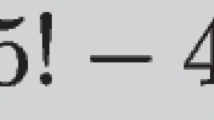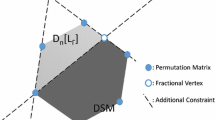Abstract
Permutation codes are widely studied objects due to their numerous applications in various areas, such as power line communications, block ciphers, and the rank modulation scheme for flash memories. Several kinds of metrics are considered for permutation codes according to their specific applications. This paper concerns some improvements on the bounds of permutation codes under Hamming metric and Kendall’s \(\tau \)-metric respectively, using mainly a graph coloring approach. Specifically, under Hamming metric, we improve the Gilbert–Varshamov bound asymptotically by a factor n, when the minimum Hamming distance d is fixed and the code length n goes to infinity. Under Kendall’s \(\tau \)-metric, we narrow the gap between the known lower bounds and upper bounds. Besides, we also obtain some sporadic results under Kendall’s \(\tau \)-metric for small parameters.
Similar content being viewed by others
References
Barg A., Mazumdar A.: Codes in permutations and error correction for rank modulation. IEEE Trans. Inf. Theory 56(7), 3158–3165 (2010).
Bose R.C., Chowla S.: Theorems in the additive theory of numbers. Comment. Math. Helv. 37, 141–147 (1962/1963).
Buzaglo S., Etzion T.: Bounds on the size of permutation codes with the Kendall \(\tau \)-metric. IEEE Trans. Inf. Theory 61(6), 3241–3250 (2015).
Čebyšev P.L.: Mémoire sur les nombres premiers. Académie Impériale des Sciences, Saint Petersburg (1850).
Chu W., Colbourn C.J., Dukes P.: Constructions for permutation codes in powerline communications. Des. Codes Cryptogr. 32(1–3), 51–64 (2004).
Colbourn C.J., Kløve T., Ling A.C.H.: Permutation arrays for powerline communication and mutually orthogonal Latin squares. IEEE Trans. Inf. Theory 50(6), 1289–1291 (2004).
de la Torre D.R., Colbourn C.J., Ling A.C.H.: An application of permutation arrays to block ciphers. Congr. Numer. 145, 5–7 (2000).
Dharwadker A.: The Independent Set Algorithm. Yoda, New Delhi (2006).
Farnoud F., Skachek V., Milenkovic O.: Error-correction in flash memories via codes in the Ulam metric. IEEE Trans. Inf. Theory 59(5), 3003–3020 (2013).
Ferreira H.C., Vinck A.J.H.: Interference cancellation with permutation trellis codes. In: 2000 VTC- Fall VTS 52nd Vehicular Technology Conference, vol. 5, pp. 2401–2407 (2000).
Frankl P., Deza M.: On the maximum number of permutations with given maximal or minimal distance. J. Comb. Theory Ser. A 22(3), 352–360 (1977).
Gao F., Yang Y., Ge G.: An improvement on the Gilbert-Varshamov bound for permutation codes. IEEE Trans. Inf. Theory 59(5), 3059–3063 (2013).
Godsil C., Royle G.: Algebraic Graph Theory. Graduate Texts in Mathematics, vol. 207. Springer, New York (2001).
Jiang A., Mateescu R., Schwartz M., Bruck J.: Rank modulation for flash memories. IEEE Trans. Inf. Theory 55(6), 2659–2673 (2009).
Jiang A., Schwartz M., Bruck J.: Correcting charge-constrained errors in the rank-modulation scheme. IEEE Trans. Inf. Theory 56(5), 2112–2120 (2010).
Kløve T., Lin T.-T., Tsai S.-C., Tzeng W.-G.: Permutation arrays under the Chebyshev distance. IEEE Trans. Inf. Theory 56(6), 2611–2617 (2010).
Mazumdar A., Barg A., Zémor G.: Constructions of rank modulation codes. IEEE Trans. Inf. Theory 59(2), 1018–1029 (2013).
Pavlidou N., Vinck A.J.H., Yazdani J., Honary B.: Power line communications: state of the art and future trends. IEEE Commun. Mag. 41(4), 34–40 (2003).
Tait M., Vardy A., Verstraete J.: Asymptotic improvement of the Gilbert-Varshamov bound on the size of permutation codes. arXiv preprint arXiv:1311.4925 (2013).
Tamo I., Schwartz M.: Correcting limited-magnitude errors in the rank-modulation scheme. IEEE Trans. Inf. Theory 56(6), 2551–2560 (2010).
Vinck A.J.H.: Coded modulation for power line communications. AE Int. J. Electron. Commun. 54, 45–49 (2011).
Wang X., Zhang Y., Yang Y., Ge G.: New bounds of permutation codes under hamming metric and kendall’s \(\tau \)-metric. arXiv preprint arXiv:1611.07188 (2016).
Acknowledgements
The authors express their gratitude to the anonymous reviewers for their detailed and constructive comments which are very helpful to the improvement of this paper. Research supported by the National Natural Science Foundation of China under Grant Nos. 11431003 and 61571310.
Author information
Authors and Affiliations
Corresponding author
Additional information
Communicated by C. Ding.
Rights and permissions
About this article
Cite this article
Wang, X., Zhang, Y., Yang, Y. et al. New bounds of permutation codes under Hamming metric and Kendall’s \(\tau \)-metric. Des. Codes Cryptogr. 85, 533–545 (2017). https://doi.org/10.1007/s10623-016-0321-5
Received:
Revised:
Accepted:
Published:
Issue Date:
DOI: https://doi.org/10.1007/s10623-016-0321-5




